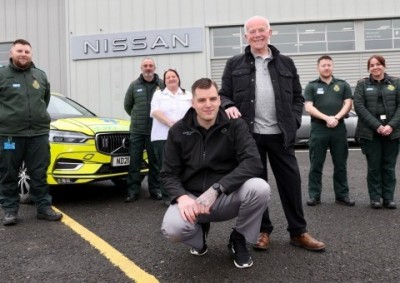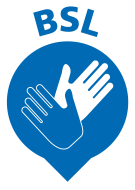
A Castletown grandfather whose life was saved by CPR has been reunited with those who the ambulance crews who came to his aid.
Frank Kelly, aged 77, was on his regular cycling route around the Nissan Sunderland Plant on Washington Road in Washington in August last year when he suffered a cardiac arrest and collapsed at the side of the road.
Nissan workers Karl Harrison and David Freeman and Kurt Burgess, who was just finishing his shift at Hyperdrive Innovation, all stopped to help and immediately leaped into action. Kurt dialled 999 and spoke to North East Ambulance Service (NEAS) health advisor Lisa Studholme and began chest compressions with support from David.
Paramedics and police arrived on scene a short time later and, with the assistance of a defibrillator, the medical professionals were able to revive Frank.
After spending six weeks in hospital, Frank is now slowly back on the mend.
“I was fit as a fiddle – or so I thought,” he said.
“I had been on the bike on the Monday and Tuesday that week but hadn’t gone out on the Wednesday because the weather was bad so, when the weather improved on the Thursday and the sun was out, I had decided to get back out. The area around Nissan is nice and flat so I go in one end and cycle round to the other.
“I don’t remember anything about it, the only thing I remember is waking up in hospital.”
Kurt, a production team leader at Hyperdrive Innovation, had received first aid training through work. He said: “I rang 999 and was taken through CPR at the side of the road by the call handler until David arrived and jumped in to finish the compressions until the crew took over.
“To be honest, it’s not really something you think about at the time, it’s just instinct to want to help keep that person alive, but saving someone’s life is one of the most rewarding things you’ll ever do.”
David, a production supervisor at Nissan, added: “My immediate thought was just that I needed to do whatever I could to help Mr Kelly until the emergency services arrived.
“Luckily, I’m CPR trained like Karl so we knew straight away that the best action was to start chest compressions.
“It’s not what you expect to end up doing on your way into work, but the training kicks in and you just try to keep a cool head while the experts arrive to take over.”
This 999 call was the first of that day’s shift for Lisa, who is based at the Trust’s Emergency Operations Centre in Hebburn. She said: “I remember the caller was very calm and listened when I gave instructions on how to perform CPR.
“To have a bystander assist with a patient until the ambulance crew arrives can make such a difference, as was evident in this case. It was also extremely helpful that the bystander gave clear and concise details of where they were and also listened and followed the instructions that I have been trained to deliver which resulted in the excellent outcome.”
Washington-based paramedic Michael Laing, who joined NEAS in 2008 before qualifying as a paramedic in 2010, was first on scene with clinical care assistant Dan Chapman.
“We were diverted away from another call to attend to Mr Kelly,” he said. “The basic information we received initially was that there was possibly a road traffic collision and that someone was in cardiac arrest with CPR in progress.”
Dan added: “As we approached the scene, the first thing I could see was a HGV lorry with its hazards on and I honestly feared the worst, I thought the patient had been involved in an RTC. I eventually saw Mr Kelly lying on the side of the road with his pedal bike next to him, and I noticed some trauma to his face. He was not breathing, and I was unable to feel a pulse.
“One of the bystanders was doing CPR to a very good standard and I remember asking him if he was happy to continue for a very short time whilst myself and Mick got our equipment set up, which he agreed and did an amazing job. The other bystanders provided safe traffic control measures and they also did a fantastic job.”
Minutes behind them were paramedic Danielle Richardson and clinical care assistant Josh Plumpton, who were on their final shift together prior to Josh beginning his training as a paramedic apprentice.
Josh said: “When we arrived, Mick and Dan were already performing CPR so Danielle and I integrated into the effort to resuscitate Mr Kelly. We defibrillated Mr Kelly and he began displaying signs of maintaining sufficient cardiac output himself, allowing us to get him into the ambulance where we then made sure he remained stable as we travelled to hospital.”
Danielle, who joined NEAS in 2006 as an ambulance care assistant in the patient transport service, before moving into emergency care and qualifying as a paramedic in 2011, said: “Mr Kelly is living proof that bystander CPR makes a massive difference!
“The bystanders were massively helpful and we were able to resuscitate Mr Kelly pretty quickly thanks to the effort of both crews and the initial effort from the Nissan staff.”
Mr Kelly was pre-alerted into Sunderland Royal Hospital, where he spent the next six weeks before being allowed home to continue to his recovery.
He said: “There’s still a long way to go but I’m getting there slowly. I’ve already met two of the lovely lads but have really wanted to meet the ambulance staff to say thank you. Without them all, I wouldn’t be here today.”
Dan added: “To have the opportunity to meet Mr Kelly again after such a serious event and see how well he has recovered really reminds me of why I chose a career in the ambulance service.
“Meeting Mr Kelly following this is quite special,” added Josh. Having the opportunity to speak to someone who the first time we met wasn't breathing is amazing.
“Early, good quality, CPR and early shocks where possible really do make the difference between people in cardiac arrest either going home to their families or not. To be able to give someone a second chance at living by doing something which is so readily available to learn is invaluable.”
As a direct result of this incident, Nissan made the decision to offer training to its entire team at the plant, and since then NEAS has delivered 26 CPR/AED courses at the plant training more than 300 delegates to date. There are a further 19 courses planned between now until the end of March 2022, which will take the total beyond 500.
Karl, a member of the Quality Assurance Team at Nissan, who lives in Hartlepool, said: “When I did my CPR training with Nissan and the ambulance service 10 years ago, I hoped I’d never have to use it, but this just shows why it is so important to get this training.
“I don’t even normally drive that way – by chance I had taken a detour to a newsagents on my way in. It was a collective effort from me and some other passers-by to keep him alive until the paramedics arrived.
“I’m delighted the company has rolled out the training at work and I’ve recommended it to many of my colleagues, you never know when you’ll need it.”
Michael Jude, HR Director at Nissan Sunderland Plant, said: “We are incredibly proud of David and Karl, who were able to keep clear heads and put their CPR training into use in what was a life or death situation.
“It is fantastic that, as a direct result, we have been able to work with NEAS to provide this essential training to so many of our team.
“I’ve been on the course and would thoroughly recommend it.”
Cardiac arrests are often confused with heart attacks. Although a heart attack can cause a cardiac arrest, they are not the same thing and having a cardiac arrest does not mean you have had a heart attack. A heart attack occurs due to a blockage in one of the arteries, whilst a cardiac arrest occurs as a result of an abnormal heart rhythm
A cardiac arrest can strike anybody, at any time, in any place, and a person’s chances of survival reduces by 10 per cent for every minute without CPR and defibrillation.

